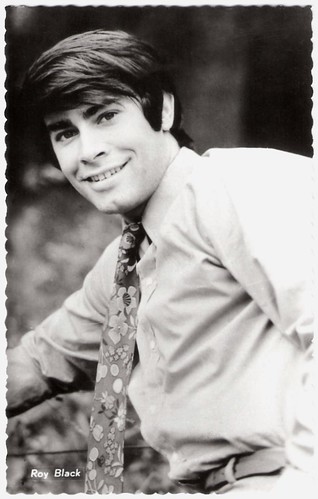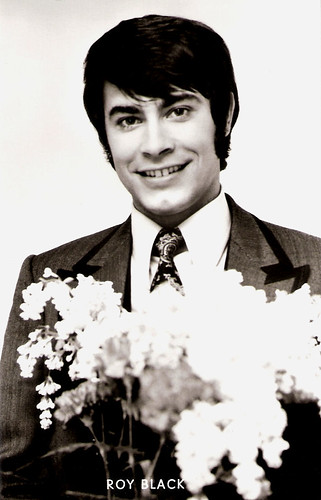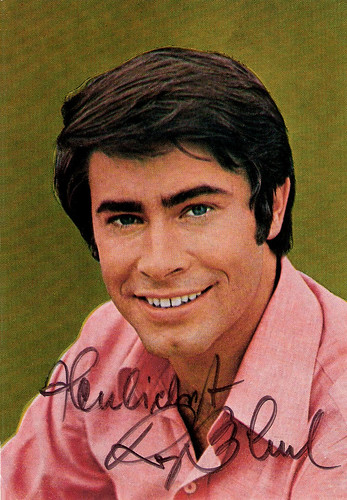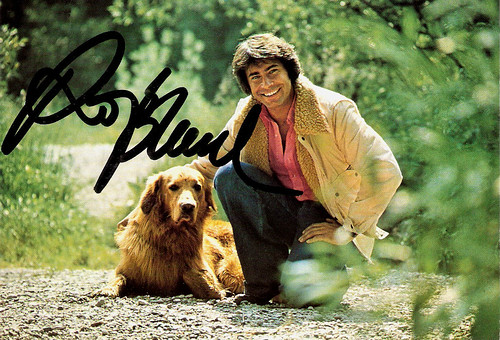
German postcard by ISV, no. K 33. Photo: Erwin Schneider.

German postcard by ISV, no. K 44. Photo: Erwin Schneider.

German postcard by Franz Josef Rüdel, Filmpostkartenverlag, Hamburg, no. F 39. Photo: Gloria / Bayer. Publicity still for Wenn du bei mir bist/When you're with me (Franz Josef Gottlieb, 1970).
All in White
Roy Black was born Gerhard Höllerich in Bobingen, Germany in 1943. He attended the gymnasium in Augsburg and, at age 20, he founded the rock and roll band Roy Black and His Cannons. His stage name derived from his black hair and his idol, Roy Orbison.
Roy Black and His Cannons achieved some local fame. After winning a talent contest they were offered a recording contract with Polydor Records. Their first two records were not a success and producer Hans Bertram decided on a solo career for Black. He also chose to switch to romantic songs for his protégé, a decision which soon led to nationwide fame.
His first solo single, 'Du bist nicht allein' (You Are Not Alone) became #4 in the German chart in 1965. The following year, his single 'Ganz in Weiß' (All in White) - a romantic song about marrying in white – sold 2.5 million copies. His 1969 song 'Dein schönstes Geschenk' (Your Most Beautiful Gift), sold one million copies by May 1970, having spent nine weeks at number one in the German chart. Other successes were 'Das Mädchen Carina' (The Girl Carina, 1969) and the international hit 'Schön ist es auf der Welt zu sein' (1971), with the 10-year-old Anita Hegerland.
From 1967, Black also took on roles in several Schlager films. His screen debut was the TV comedy Jetzt schlägt's 13/13 'O Clock (Truck Branss, 1967) with Peter Alexander. In the cinema, he was seen in such light entertainment vehicles as Paradies der flotten Sünder/Paradise of the Fun-loving Sinners (Rolf Olsen, August Rieger, Géza von Cziffra, 1968) with Hans-Jürgen Bäumler, and Unser Doktor ist der Beste/Our Doctor is the Best (Harald Vock, 1969) with Peter Weck.
In Hilfe, ich liebe Zwillinge/Help, I Love Twins (Peter Weck, 1969), he starred opposite Uschi Glas. Glas and Black appeared in five films together and were called the new Traumpaar (Dream couple) of the German film.

German postcard by Filmbilder-Vertrieb Ernst Freihoff, Essen, no. 979. Retail price: 10 Pfg. Photo: Erwin Schneider.

German postcard by Filmbilder-Vertrieb Ernst Freihoff, Essen, no. AX 6643.

German postcard by Filmbilder-Vertrieb Ernst Freihoff, Essen, no. AX 7001. Photo: Polydor / Bockelberg.

German postcard by Friedrich W. Sander-Verlag, Minden, no. 3129. Photo: Lothar Winkler.
As wooden as any tree in the Schwarzwald
In the early 1970s Roy Black also appeared in Heimatfilms (nostalgic back-to-basics films, set in some rural part of German-speaking central Europe) like Kinderarzt Dr. Fröhlich/Pediatrician Dr. Fröhlich (Kurt Nachmann, 1972) and Grün ist die Heide/The Heath Is Green (Harald Reinl, 1972).
In the 1960s and 1970s, the traditional German cinema with its typical genres as the Heimatfilm and the Schlagerfilm was in crisis due to the advent of colour television. The Roy Black vehicles belong to the last examples of these German film genres. Black’s final film was Schwarzwaldfahrt aus Liebeskummer/A Black Forest Trip from Lovesickness (Werner Jacobs, 1974).
IMDb, reviewer Jan Onderwater writes: "This combination of Schlager- and Heimatfilm is neither good nor bad, it is just absolute nothingness as it could only come from hack director Werner Jacobs. Popular singer Roy Black plays as wooden as any tree in the Schwarzwald and the rest of the cast is not even worth mentioning; the forest is the best actor. Moreover, it is all so narrow-minded." In 1974 Black announced his engagement to Swedish model Silke Vagts. The couple got married in Munich the same year, and in 1976 their son Torsten was born. They divorced in 1985.
After being Germany's most popular pop idol in the late 1960s and early 1970s, Black's career struggled for more than a decade due to low record sales and personal problems. In 1975 he left his producer Hans Bertram but to no avail. However, in the last years of his life, he had a surprising comeback as a singer and as a leading actor in the hit TV show Ein Schloß am Wörthersee/Lakeside Hotel (Erich Tomek, 1990-1991).
Then in 1991, Roy Black died of heart failure, in Heldenstein, near Mühldorf am Inn. He died one month after his longtime companion Carmen Böhning gave birth to their daughter Nathalie (1991). In 1996, Christoph Waltz played Roy Black in the biopic Du bist nicht allein - Die Roy Black Story/You Are Not Alone – The Roy Black Story (Peter Keglevic, 1996).

German promotion card by Polydor.

German promotion card by Polydor.

German promotion card by Polydor.
Roy Black sings Du Bist nicht allein (1965). Source: teufelchenmikel (YouTube).
Roy Black sings Ave Maria in Kinderarzt Dr. Fröhlich/Pediatrician Dr. Fröhlich (1972). Source: MaikFührer (YouTube).
Sources: Roy-Black.net (German), Wikipedia and IMDb.
This post was last updated on 28 May 2023.
No comments:
Post a Comment